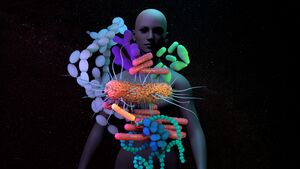Gut-Brain Axis: the relationship between the gut microbiota and anxiety and depression
Introduction

By Samantha Lee
Humans have evolved throughout the many years with microbes. Microbes play an important role in not only human health but also human disease. The human intestinal tract contains a wide variety of microorganisms, all of which have a large impact on health and disease [1]. This microbiota has recently been studied more in depth as researchers discovered that microbes have a larger impact on human health than once understood. Antibiotics and diet have been shown to alter the diversity of the gut microbiota, leading to the possibility of irritable bowel syndrome (IBS) and inflammatory bowel disease (IBD) since patients with IBS and IBD have been shown to have unstable gut microbial populations [2].
At right is a sample image insertion. It works for any image uploaded anywhere to MicrobeWiki.
The insertion code consists of:
Double brackets: [[
Filename: PHIL_1181_lores.jpg
Thumbnail status: |thumb|
Pixel size: |300px|
Placement on page: |right|
Legend/credit: Magnified 20,000X, this colorized scanning electron micrograph (SEM) depicts a grouping of methicillin resistant Staphylococcus aureus (MRSA) bacteria. Photo credit: CDC. Every image requires a link to the source.
Closed double brackets: ]]
Other examples:
Bold
Italic
Subscript: H2O
Superscript: Fe3+
Sample citations:
[1]
[2]
A citation code consists of a hyperlinked reference within "ref" begin and end codes.
To repeat the citation for other statements, the reference needs to have a names: "<ref name=aa>"
The repeated citation works like this, with a forward slash.[1]
Section 1
Include some current research, with at least one figure showing data.
Every point of information REQUIRES CITATION using the citation tool shown above.
Section 2
Include some current research, with at least one figure showing data.
Section 3
Include some current research, with at least one figure showing data.
Section 4
Conclusion
References
Authored for BIOL 238 Microbiology, taught by Joan Slonczewski,at Kenyon College,2024
